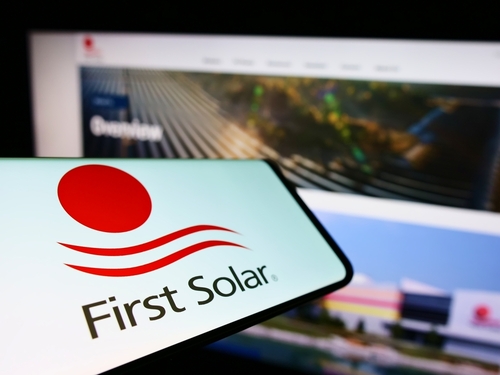First Solar (NASDAQ:FSLR), the maker of advanced thin-film photovoltaic (PV) modules, saw its stock tumble from late summer to late fall this year as high interest rates discouraged homeowners and others from taking on solar projects. However, analysts across Wall Street forecast significant upside potential for this stock on the expectation that the Federal Reserve will lower interest rates in the coming year.
Claim 50% Off TipRanks Premium and Invest with Confidence
- Unlock hedge-fund level data and powerful investing tools designed to help you make smarter, sharper decisions
- Stay ahead of the market with the latest news and analysis so your portfolio is always positioned for maximum potential

I concur with these analysts and see a bright future for First Solar. Besides for the likely boost from lower rates in the months to come, there is a larger secular trend towards renewable energy. Plus, the company enjoys an industry-leading PV module product and could benefit from the continued rollout of the Inflation Reduction Act (IRA).
Let’s take a closer look at First Solar below.
Interest Rate Boost Could Bolster Broader Trend
In late December, the Federal Open Market Committee signaled plans for at least three interest rate reductions in 2024 and beyond. The move sent solar companies like FSLR upward, reversing course after a downward-trending period since late in the summer. The link between interest rates and the welfare of solar energy firms is related to the fact that most customers buy solar panels and related equipment on a purchase agreement lasting many years, making long-term payments that will vary based on rates. The higher the rates, the less likely some customers are to be willing to make the leap to solar. With rates expected to fall from multi-decade highs in the coming months, it’s likely that some potential solar customers who were previously priced out by looming interest payments will be able to convert to renewable energy.
Besides for the tailwind of more favorable interest rates, First Solar is poised to benefit from other trends nudging customers toward renewable energy. The cost of residential electricity has risen year-over-year in all but two of the last 20 years as of 2023. A short-term influx of cheap solar modules from Asian companies has threatened U.S. manufacturing but is likely to drive prices down, potentially leading to wider adoption in this country. Perhaps even more importantly, environment-conscious customers have turned to solar and other green energies in increasing numbers in the last few years, and this trend is forecast to continue well into the 2030s. A 2021 Energy Department survey suggested that solar energy could account for a whopping 40% of U.S. electricity generation by 2035, while it was just 5% in 2022.
First Solar’s Standout Product and Profile
Analysts believe that First Solar’s unique PV modules stand out relative to those produced by rival companies. First Solar’s PVs are lower-carbon alternatives to traditional modules; analysts at TD Cowen have described them as “generally a better product versus crystalline silicon modules.” So while the entire solar energy could get a boost from the factors above, First Solar may be uniquely positioned to capture a larger share of the growing solar market.
First Solar’s strong backlog and balance sheet also position it favorably compared with its peers. In its Q3 earnings report, the company left its full-year 2023 net cash balance guidance of $1.5 billion to $1.8 billion unchanged while raising its low-end operating income guidance for the year from $745 million to $770 million. The company has also recently forecast that operating margins will climb from about 10% to 24% in the next three years and that gross margins could rise from about 20% to 30% over the same timeframe. It has a strong bookings backlog of 81.8 gigawatts through 2030. As the Inflation Reduction Act continues to support the industry more broadly, First Solar is poised to receive up to $710 million in total from the IRA for 2023.
Potential Headwinds in an Election Year
While all of these factors point to First Solar’s upside potential, it’s essential to also keep in mind that there are some headwinds at play in the months to come as well. First, the U.S. is just entering the winter season, when installations of solar panels tend to be at a low relative to warmer months. Coupled with the uncertainty about the timing of when the Fed may lower interest rates, the benefits from the factors above may be delayed by several months.
The U.S. is also entering into a major election year. The Inflation Reduction Act, widely opposed by Republican legislators before its passing, has been a major boon for renewable energy firms like First Solar. TD Cowen analysts say they “continue to observe investor anxiety around a Republican sweep for the sector.” A shift in political leadership could spell an end to domestic manufacturing credits and a whittling away at price premiums that have been boosted by the IRA.
What is the Price Target for FSLR Stock?
On TipRanks, FSLR comes in as a Strong Buy based on 17 Buys and four Hold ratings assigned by analysts in the past three months. The average First Solar stock price target is $230.68, implying 35.7% upside potential.
Conclusion: Should You Consider FSLR?
First Solar stock has fallen in recent months, but analysts across the Street expect it to swing back upward with likely interest rate drops and continued trends toward renewable energy adoption. There are reasons to be cautious, including the impact of the 2024 election, but the company still enjoys a solid Strong Buy rating.
















